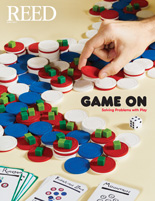
IRIS login | Reed College home Volume 96, No. 2: June 2017
Prof. Peter Rock Works Backwards to Cast "Spells"
The fragmentary novel Spells has its genesis when Prof. Peter Rock [creative writing 2001-] was working as a security guard in an art museum, amusing himself by making up stories for pieces in the galleries.
“I entertained myself by trying to make up a story for each photograph, painting and object in the museum,” he explained when he spoke on campus September 25. “However, we guards weren't allowed to write on the job. Bending this rule, I carried a scrap of paper and a little pencil and then, in the minute or so when I was going down the stairway to the next floor, I'd furtively scribble a few words, to remind me of the stories I'd made up in my head. When I got to the break room in the basement, I'd write down as much as I could, in the half hour, and then begin again. Later, I'd go home and work some more on it all."
The Spells project came from a desire to get back to that sense of play in writing, Rock says, “it allowed me to expand what I thought was possible in terms of storytelling.”
So while the narrative often precedes any images in a novel, in this case the images came first. Rock chose the images from a selection provided by five different artists, eventually ending with a series of 43 images and 31 stories. The artists were Sofia Borazanian, Sara Lafleur-Vetter, Peter McCollough, Shaena Mallett, and Colleen Plumb. Throughout the project it was important to Rock that he not know the artists so he could have as much freedom as possible with their images. During the talk he gave on Friday in the Performing Arts Building he remarked that when he showed the photographers his stories afterwards a lot of them commented that the context was wrong but the underlying emotion dead-on.
Spells is not a book. It isn’t bound or printed, and the text isn’t available. It is sound and image, each of the 43 segments spoken and recorded, in audio and video. Each segment has an accompanying photo, which Rock says he, “treated more as glimpses into the world than photographs.” For Rock what’s important isn’t the novel as a whole, but rather the fragments that the reader “can enter at any point, the hope is that a small subset will suggest what the whole is about.” The fragments use a variety of different registers and tones to tell their stories, creating a novel that can be read as a whole or in parts.
The noncommercial nature of the project enabled Rock to have full control over it, and to let the project develop on its own. Last year he won a fellowship from the Guggenheim Foundation to pursue the project. For Rock the amount of interest the project has generated has “been so heartening because I think anyone who writes anything wants someone to pay attention to it and think hard about it.”
Madelyn Villano ’14 created the sounds and music for the project, which is currently featured as an installation at Blue Sky Gallery in Portland and was presented by Rock and Stephanie Snyder ’91, curator of the Cooley Gallery [2003- ], with music by Villano in the Massee Performance Lab in the PAB at 4 PM on Friday, September 28.
Tags: Peter Rock, Spells



LATEST COMMENTS
steve-jobs-1976 I knew Steve Jobs when he was on the second floor of Quincy. (Fall...
Utnapishtim - 2 weeks ago
Prof. Mason Drukman [political science 1964–70] This is gold, pure gold. God bless, Prof. Drukman.
puredog - 1 month ago
virginia-davis-1965 Such a good friend & compatriot in the day of Satyricon...
czarchasm - 4 months ago
John Peara Baba 1990 John died of a broken heart from losing his mom and then his...
kodachrome - 7 months ago
Carol Sawyer 1962 Who wrote this obit? I'm writing something about Carol Sawyer...
MsLaurie Pepper - 8 months ago
William W. Wissman MAT 1969 ...and THREE sisters. Sabra, the oldest, Mary, the middle, and...
riclf - 10 months ago